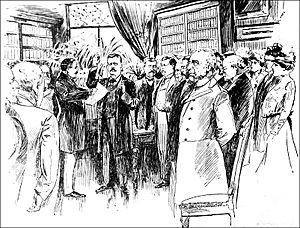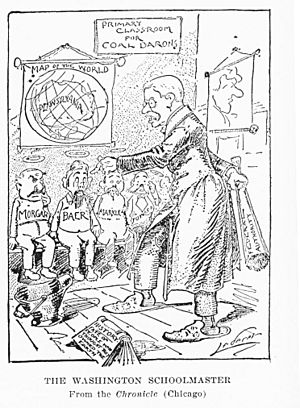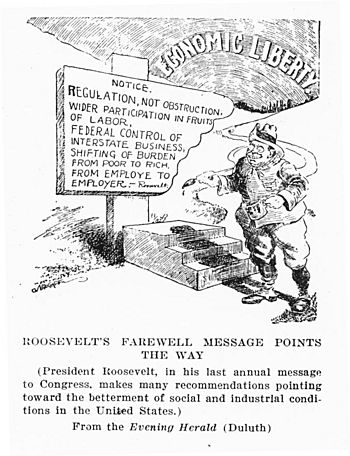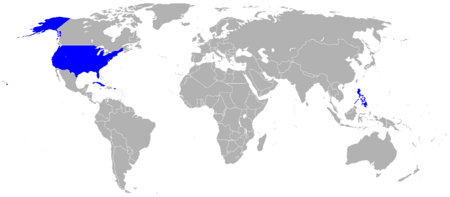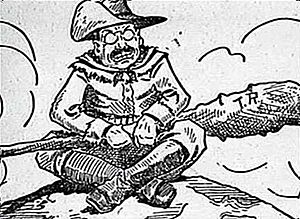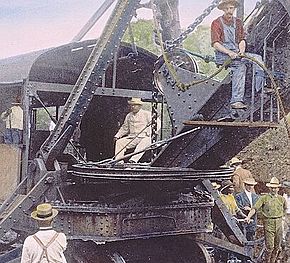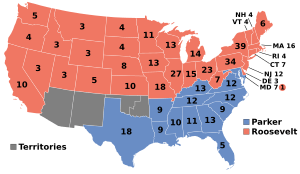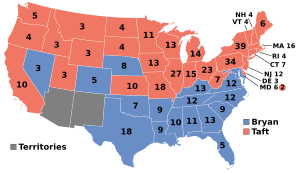Presidency of Theodore Roosevelt facts for kids
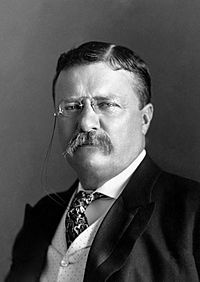 |
|
Quick facts for kids
Presidency of Theodore Roosevelt
|
|
|---|---|
| September 14, 1901 – March 4, 1909 | |
| Cabinet | See list |
| Party | Republican |
| Election | 1904 |
| Seat | White House |
|
← William McKinley • William Howard Taft →
|
|
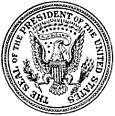 |
|
| Seal of the President (1894–1945) |
|
The presidency of Theodore Roosevelt began on September 14, 1901. This was when Theodore Roosevelt became the 26th president of the United States. He took office after President William McKinley was sadly assassinated. His time as president ended on March 4, 1909. Roosevelt had only been the vice president for a short time before he became president. He was a Republican. He ran for president in 1904 and won by a lot of votes. His friend and chosen successor, William Howard Taft, became the next president.
Roosevelt was a Progressive reformer. He was known as a "trust buster" because he worked to control big businesses. He passed laws like the Pure Food and Drug Act. This law created the Food and Drug Administration to make sure our food was safe. He also passed the Hepburn Act, which gave the Interstate Commerce Commission more power over railroads. Roosevelt believed in capitalism but was against monopolies. These are when one company controls everything. His "Square Deal" promised fairness for everyone. This included rules for railroad prices and safe food and drugs. He wanted a fair deal for regular people and business owners.
Roosevelt cared about both businesses and workers. He helped stop a big coal strike in 1902. He also strongly supported protecting nature. He made many new national parks and national forests. After 1906, he became even more progressive. He spoke out against big businesses and supported labor unions.
In foreign affairs, Roosevelt wanted the United States to be a strong naval power. He also wanted to protect the Monroe Doctrine. This was a policy to keep European countries out of Latin America. He led the building of the Panama Canal. This canal made it much easier to travel between the Atlantic and Pacific oceans. It also helped American trade and safety. He took over the colonies that the U.S. got from the Spanish–American War in 1898. He ended the U.S. military rule in Cuba. He also kept U.S. troops in the Philippines for a long time.
Much of his foreign policy focused on Japan and Germany. He wanted to reduce European power in Latin America. He helped solve the Venezuela Crisis. He also announced the Roosevelt Corollary. This meant the U.S. would step in if Latin American countries couldn't pay their debts. Roosevelt helped end the Russo-Japanese War (1904–1905). For this, he won the 1906 Nobel Peace Prize. He also worked to improve relations with Great Britain.
Historians often rank Roosevelt among the top U.S. presidents. His face is carved into Mount Rushmore alongside other great leaders.
Contents
- Becoming President: How Roosevelt Took Office
- Working as President: Roosevelt's Administration
- Judges Appointed by Roosevelt
- What Roosevelt Did at Home: Domestic Policy
- Working with Other Countries: Foreign Policy
- Elections During Roosevelt's Presidency
- Roosevelt's Place in History
Becoming President: How Roosevelt Took Office
Before becoming president, Roosevelt was the Assistant Secretary of the Navy. He was also the governor of New York. In the 1900 election, he became William McKinley's running mate. This meant he would be vice president if McKinley won.
Roosevelt became president after William McKinley was assassinated. An anarchist named Leon Czolgosz shot McKinley on September 6, 1901. McKinley died on September 14. Roosevelt was sworn into office on the same day McKinley died. This happened at the Ansley Wilcox House in Buffalo, New York.
John R. Hazel, a U.S. District Judge, gave Roosevelt the oath of office. Roosevelt was almost 43 years old. This made him the youngest president in U.S. history. He still holds that record today.
When asked if he was ready, Roosevelt said:
I will take the oath. And in this hour of deep and terrible national bereavement, I wish to state that it shall be my aim to continue, absolutely without variance, the policy of President McKinley, for the peace and honor of our beloved country.
Roosevelt later said he didn't have many specific goals for domestic policy at first. He mostly agreed with the Republican Party on economic issues. However, he had stronger ideas about foreign policy. He wanted the United States to be a great power in the world.
Working as President: Roosevelt's Administration
Roosevelt's Cabinet Members
| The Roosevelt Cabinet | ||
|---|---|---|
| Office | Name | Term |
| President | Theodore Roosevelt | 1901–1909 |
| Vice President | none | 1901–1905 |
| Charles W. Fairbanks | 1905–1909 | |
| Secretary of State | John Hay | 1901–1905 |
| Elihu Root | 1905–1909 | |
| Robert Bacon | 1909 | |
| Secretary of Treasury | Lyman J. Gage | 1901–1902 |
| L. M. Shaw | 1902–1907 | |
| George B. Cortelyou | 1907–1909 | |
| Secretary of War | Elihu Root | 1901–1904 |
| William Howard Taft | 1904–1908 | |
| Luke Edward Wright | 1908–1909 | |
| Attorney General | Philander C. Knox | 1901–1904 |
| William Henry Moody | 1904–1906 | |
| Charles Joseph Bonaparte | 1906–1909 | |
| Postmaster General | Charles Emory Smith | 1901–1902 |
| Henry Clay Payne | 1902–1904 | |
| Robert Wynne | 1904–1905 | |
| George B. Cortelyou | 1905–1907 | |
| George von Lengerke Meyer | 1907–1909 | |
| Secretary of the Navy | John Davis Long | 1901–1902 |
| William Henry Moody | 1902–1904 | |
| Paul Morton | 1904–1905 | |
| Charles Joseph Bonaparte | 1905–1906 | |
| Victor H. Metcalf | 1906–1908 | |
| Truman Handy Newberry | 1908–1909 | |
| Secretary of the Interior | Ethan A. Hitchcock | 1901–1907 |
| James Rudolph Garfield | 1907–1909 | |
| Secretary of Agriculture | James Wilson | 1901–1909 |
| Secretary of Commerce & Labor | George B. Cortelyou | 1903–1904 |
| Victor H. Metcalf | 1904–1906 | |
| Oscar Straus | 1906–1909 | |
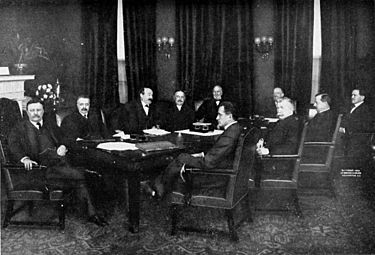
Roosevelt wanted a smooth start to his presidency. He asked President McKinley's cabinet members to stay. Key people like Secretary of State John Hay and Secretary of the Treasury Lyman J. Gage agreed. Secretary of War Elihu Root was a close friend and stayed on. Attorney General Philander C. Knox also became a strong helper in Roosevelt's team.
Over time, Roosevelt made some changes. He replaced Gage with L. M. Shaw. He also appointed Henry C. Payne as Postmaster General. In 1903, Roosevelt created the Department of Commerce and Labor. He named George B. Cortelyou as its first head.
Later, William Howard Taft became Secretary of War. Taft had been the governor-general of the Philippines. After John Hay died, Roosevelt convinced Elihu Root to return as Secretary of State. Root stayed in this role until Roosevelt's presidency ended.
Working with the Press
Roosevelt made the White House a daily center for news. He gave interviews and allowed photos. He even gave reporters their own room inside the White House. This was the start of presidential press briefings.
The reporters were thankful for this access. They gave Roosevelt a lot of news coverage. Roosevelt also chose which reporters he wanted to work with.
Judges Appointed by Roosevelt
Roosevelt appointed three judges to the Supreme Court. His first choice was Oliver Wendell Holmes, Jr.. Holmes had been a chief justice in Massachusetts. He joined the Supreme Court in 1902 and served until 1932. Sometimes, Holmes's decisions on big businesses made Roosevelt upset.
His second appointment was William R. Day, a former Secretary of State. Day often voted with Roosevelt on cases against big businesses. He served on the court from 1903 to 1922. In 1906, Roosevelt appointed Attorney General William Henry Moody. Moody served until 1910 when he retired due to health issues.
Roosevelt also appointed many other federal judges. He named 18 judges to the Courts of Appeals. He also appointed 53 judges to the district courts.
What Roosevelt Did at Home: Domestic Policy
The "Square Deal" and Progressivism
Roosevelt wanted to create a "Square Deal" for everyone. This meant fairness between businesses and workers. He passed many new laws to achieve this. Progressivism was a strong movement at the time. Roosevelt was a leading voice for it.
Progressivism had two main ideas. First, it used science and technology to solve national problems. It aimed to make things more efficient and modern. Second, it fought against corruption. This included corruption in politics, labor unions, and large corporations.
Historian G. Warren Chessman described Roosevelt's goals. These included:
- Making large companies responsible to the public.
- Using publicity to fix problems with big businesses.
- Regulating railroad prices.
- Helping solve conflicts between businesses and workers.
- Protecting natural resources.
- Helping people who were less fortunate.
Controlling Big Businesses and Trusts
In the late 1800s, huge companies like Standard Oil grew very powerful. They bought out rivals or made deals to stop competition. Many companies formed "trusts." This meant one group of leaders controlled several companies.
Congress had passed the Sherman Antitrust Act in 1890. This law was meant to control trusts. But the Supreme Court had limited its power. By 1902, the 100 biggest companies controlled 40% of all industrial wealth in the U.S. Roosevelt didn't oppose all trusts. He only wanted to regulate "bad trusts" that he believed hurt the public.
First Term Actions
When Roosevelt became president, he suggested federal rules for trusts. He believed states weren't stopping harmful trusts. So, he wanted a new government department to regulate companies that traded across states. He also wanted to improve the Interstate Commerce Act of 1887. This law had failed to control railroads.
In 1902, the Justice Department announced a lawsuit against the Northern Securities Company. This was a railroad company formed by powerful businessmen like J. P. Morgan. Attorney General Philander C. Knox led the case himself. Knox also filed a case against the "Beef Trust." This trust was unpopular because meat prices were very high. These lawsuits showed Roosevelt was serious about controlling trusts.
After the 1902 elections, Roosevelt pushed for new laws. He wanted to ban railroads from giving special discounts to big companies. He also wanted a Bureau of Corporations. This bureau would study and report on unfair business practices. Roosevelt spoke directly to the public to get support for his plans. He said the new laws would fight the power of Standard Oil.
His efforts worked. Congress approved the creation of the United States Department of Commerce and Labor. This department included the Bureau of Corporations. Roosevelt believed that if bad business practices were made public, companies would stop them. Congress also created the Antitrust Division in the Justice Department. Roosevelt also passed the Elkins Act. This law limited railroad discounts.
In 1904, the Supreme Court sided with the government in the Northern Securities Co. v. United States case. This was the first time the government successfully prosecuted a large, integrated company. The next year, his administration won another big case. This was Swift and Company v. United States, which broke up the Beef Trust.
Second Term Actions
After winning re-election, Roosevelt wanted to pass more laws quickly. He focused on laws that would build on his first term's successes. He believed more federal rules were needed for businesses that operated across state lines. States couldn't control these large trusts alone. Also, the Justice Department couldn't handle all the antitrust cases by itself.
Reports in McClure's magazine made many Americans want stronger laws. They wanted to improve the Elkins Act, which hadn't done enough to stop railroad discounts. Roosevelt also wanted to give more power to the Interstate Commerce Commission (ICC). This group was created in 1887 to regulate railroads. Roosevelt's call for new laws faced strong opposition from businesses and conservative politicians.
In late 1905, Roosevelt asked Senator Jonathan P. Dolliver to introduce a bill. This bill included Roosevelt's railroad regulation ideas. It was also introduced in the House as the Hepburn Bill. The House passed it easily. But the Senate, led by conservatives like Nelson Aldrich, was a bigger challenge.
Opponents of the Hepburn Bill focused on how courts would review the ICC's decisions. Roosevelt and progressives wanted courts to only check if the process was fair. Conservatives wanted courts to decide if the rates themselves were fair.
Roosevelt eventually accepted a compromise. This amendment allowed for some court review of the ICC's power. With this change, the Senate passed the Hepburn Bill by a large vote. Roosevelt signed the Hepburn Act into law on June 29, 1906. This law gave the ICC power over railroad rates, fees, and other operations.
Roosevelt also pushed for food safety laws. This was largely due to Upton Sinclair's novel, The Jungle. The book showed terrible conditions in meatpacking plants. Congress passed the Federal Meat Inspection Act of 1906. They also passed the Pure Food and Drug Act. These laws required food and drugs to be labeled. They also required meatpacking plants to be clean.
Roosevelt continued to file antitrust lawsuits in his second term. A lawsuit against Standard Oil in 1906 led to that company being broken up in 1911. Many large trusts also agreed to work with the Bureau of Corporations. For example, U.S. Steel avoided a lawsuit by letting the Bureau investigate its business.
Protecting Nature: Conservation Efforts
Roosevelt was a strong supporter of protecting nature. He made conservation a top priority for the country. His efforts aimed to protect the environment. But they also wanted to make sure everyone, not just a few companies, benefited from natural resources.
His main advisor on environmental issues was Gifford Pinchot. Pinchot was the head of the Bureau of Forestry. Roosevelt gave Pinchot more power by moving control of national forests to his bureau. This bureau was renamed the United States Forest Service. Pinchot then put strong conservation policies into action in the national forests.
Roosevelt supported the Newlands Reclamation Act of 1902. This law helped build dams to water small farms. He also put 230 million acres of land under federal protection. In 1906, Congress passed the Antiquities Act. This law gave the president power to create national monuments on federal lands. Roosevelt protected more federal land, national parks, and nature preserves than all previous presidents combined.
He created the Inland Waterways Commission to plan water projects. In 1908, he hosted the Conference of Governors. This meeting aimed to get more support for conservation. After the conference, Roosevelt created the National Conservation Commission. This group took inventory of the nation's natural resources.
Roosevelt's policies faced some challenges. Environmentalists like John Muir wanted nature preserved for its beauty. But Roosevelt agreed with Pinchot's idea. Pinchot believed in using forests to produce the most useful crops or services. He wanted to keep producing them for future generations. Others, like Senator Henry M. Teller, opposed conservation. They thought it would stop economic growth in the West. They also worried about too much power in Washington. This opposition slowed down conservation efforts later in Roosevelt's presidency.
Working with Labor
Roosevelt usually didn't get involved in labor disputes. But he believed the president should step in if a strike hurt the public. Union membership had doubled before Roosevelt took office. He saw labor unrest as a big threat to the country. However, he also felt for many workers because of their tough conditions.
In 1902, the United Mine Workers (UMW) union started a strike. This was the anthracite coal strike. They wanted an eight-hour day and higher pay. The mine owners refused to talk, and the strike continued. Coal prices went up a lot.
Roosevelt invited the union leaders and mine owners to the White House. But the owners still refused to negotiate. With help from Roosevelt and others, the owners finally agreed. They allowed a special commission to suggest a solution. In 1903, the commission ordered pay raises and a shorter workday. However, the union was not officially recognized.
After 1902, Roosevelt didn't intervene much in labor disputes. Courts started to get more involved. They issued orders to stop strikes.
Civil Rights and Race Relations
Roosevelt tried to improve race relations. But like many leaders of his time, he didn't do much on most racial issues. Booker T. Washington, a very important Black leader, was invited to dinner at the White House. This happened on October 16, 1901. Washington was an important advisor to Republican politicians. He believed in working with the Jim Crow laws that created racial segregation.
News of the dinner caused a big outcry from white people, especially in the South. Roosevelt never invited a Black person to dinner at the White House again. However, he continued to ask Washington for advice on appointments. He also avoided Southern Republicans who wanted to exclude Black people from office.
Roosevelt spoke out against lynchings. But he did little else to help African-American civil rights. In 1906, he approved the dishonorable discharge of Black soldiers. This was after a violent event in Brownsville, Texas, known as the Brownsville Raid. Roosevelt was criticized for this decision. The controversy lasted through the rest of his presidency.
Economic Challenges: The Panic of 1907
In 1907, Roosevelt faced a big economic crisis. The U.S. stock market started to drop. Many in the financial world blamed Roosevelt's policies. The government didn't have a strong central banking system. So, it couldn't easily respond to the economic downturn.
The slump became a full panic in October 1907. Two investors failed to take over a company called United Copper. Financier J.P. Morgan worked with Secretary of the Treasury George B. Cortelyou. Morgan gathered businessmen to prevent a total crash. They promised their own money to help. Roosevelt helped Morgan by allowing U.S. Steel to buy another company. This was allowed despite concerns about monopolies. He also let Cortelyou raise money and give federal funds to banks.
Roosevelt's popularity on Wall Street dropped after the panic. But he remained popular with the general public. After the panic, most leaders in Congress agreed that the nation's financial system needed changes. Congress passed the Aldrich–Vreeland Act. This law created the National Monetary Commission. This commission studied the banking system. Its ideas later led to the creation of the Federal Reserve System.
Tariffs and Trade
High tariffs were a long-standing Republican policy. Tariffs are taxes on imported goods. They protected American factories from foreign competition. They also helped keep wages high in American factories. In 1901, tariffs provided over one-third of the government's income.
President McKinley had strongly supported high tariffs. The Dingley Act of 1897 greatly increased tariff rates. Unlike other Republican presidents, Roosevelt was not a strong supporter of high tariffs. He didn't focus much on them.
The issue of tariffs was quiet during Roosevelt's first term. But it remained important for both political parties. People who wanted lower tariffs asked Roosevelt to call a special meeting of Congress. Roosevelt only cautiously supported a small cut in tariff rates. No major action was taken on tariffs during his time in office.
In the early 1900s, prices started to rise. Democrats and others who wanted free trade blamed high tariffs for this. Reducing tariffs became a more important national issue. Congress would pass a major tariff law in 1909, shortly after Roosevelt left office.
Moving to the "Left Center" (1907–1909)
By 1907, Roosevelt saw himself as part of the "left center" of the Republican Party. He explained his balancing act:
Again and again in my public career I have had to make head against mob spirit, against the tendency of poor, ignorant and turbulent people who feel a rancorous jealousy and hatred of those who are better off. But during the last few years it has been the wealthy corruptionists of enormous fortune, and of enormous influence through their agents of the press, pulpit, colleges and public life, with whom I've had to wage bitter war."
Public anger at corporate scandals grew. Journalists like Lincoln Steffens and Ida Tarbell wrote about these issues. This led to a split in the Republican Party. There were conservatives like Nelson Aldrich and progressives like Albert B. Cummins. Roosevelt didn't fully join the left wing of his party. But he adopted many of their ideas.
In his last two years, Roosevelt changed his approach to big business. He criticized his conservative opponents. He called on Congress to pass new, more radical laws. He wanted to replace the idea of laissez-faire (government not interfering in business). He wanted the government to have a bigger role in regulating the economy.
In January 1908, Roosevelt sent a special message to Congress. He called for a new employer's liability law. He also wanted a national law for how companies are formed. He proposed a federal income tax and inheritance tax for the rich. He wanted to limit how courts could stop labor unions during strikes. He also called for an eight-hour workday for federal employees. He proposed a postal savings system and a law to stop companies from giving money to political campaigns.
Roosevelt's strong stance was popular in some parts of the country. But it seemed too extreme to many eastern Republicans and business leaders. Some Democrats even admired Roosevelt's ideas. Despite this, Roosevelt never thought about leaving the Republican Party. Conservative Republicans in Congress blocked many of his ambitious plans. However, Roosevelt did pass a new Federal Employers Liability Act. He also passed laws to limit child labor in Washington, D.C.
New States Joining the Union
One new state joined the United States while Roosevelt was president. This was Oklahoma. It was formed from Indian Territory and Oklahoma Territory. Oklahoma became the 46th state on November 16, 1907. The Oklahoma Enabling Act also encouraged New Mexico Territory and Arizona Territory to become states later.
Working with Other Countries: Foreign Policy
Foreign policy was a shared effort between Roosevelt and Secretary of State John Hay. Hay handled many daily tasks and ceremonies. But Roosevelt personally managed all the big issues. After Hay died in 1905, Roosevelt named Elihu Root as the new Secretary of State. William Howard Taft became Secretary of War.
"Big Stick Diplomacy"
Roosevelt was good at creating memorable phrases. "Big stick" was his famous saying for his strong foreign policy. He said, "Speak softly and carry a big stick; you will go far." Roosevelt described his style as thinking ahead and acting decisively before a crisis.
His "big stick diplomacy" had five parts. First, a country needed a strong military. This meant a powerful navy. Second, a country should act fairly toward other nations. Third, never bluff. Fourth, only strike if ready to strike hard. Fifth, allow the other side to save face if they lose.
The United States as a World Power
After winning the war with Spain, the U.S. became a power in both the Atlantic and Pacific oceans. It was already the biggest economic power. Roosevelt wanted to keep expanding American influence. In his 1905 Inaugural Address, he said:
We have become a great nation, forced by the fact of its greatness into relations with the other nations of the earth, and we must behave as beseems a people with such responsibilities. Toward all other nations, large and small, our attitude must be one of cordial and sincere friendship. We must show not only in our words, but in our deeds, that we are earnestly desirous of securing their good will by acting toward them in a spirit of just and generous recognition of all their rights....No weak nation that acts manfully and justly should ever have cause to fear us, and no strong power should ever be able to single us out as a subject for insolent aggression.
Roosevelt believed the U.S. had a duty to keep a balance of power in the world. He wanted to reduce tensions. He also strongly upheld the Monroe Doctrine. This American policy opposed European colonialism in the Western Hemisphere. Roosevelt saw Germany as the biggest threat. He strongly opposed any German military base in the Caribbean Sea.
Roosevelt also tried to increase U.S. influence in East Asia and the Pacific. Here, Japan and Russia were competing for power in Korea and China. He continued McKinley's Open Door Policy. This policy called for China's economy to be open to trade from all countries.
Roosevelt helped organize the Algeciras Conference. This meeting temporarily solved a crisis in Morocco in 1905–1906. Germany had protested France and Britain's agreement to let France control Morocco. Roosevelt helped the countries reach an agreement in April 1906.
After the Spanish–American War
The Philippines
Americans argued a lot about what to do with the new territories. Roosevelt believed Cuba should become independent quickly. He thought Puerto Rico should remain a semi-independent territory. He wanted U.S. forces to stay in the Philippines. He wanted to help them create a stable, democratic government. This was even though there was an insurrection led by Emilio Aguinaldo. Roosevelt worried that if the U.S. left too soon, the Philippines would become unstable or Germany might take over.
The Filipino rebellion mostly ended in 1902. The rebels accepted American rule. However, problems continued in the southern areas. There, the Muslim Moros resisted American rule. Roosevelt continued McKinley's policy of buying out Catholic friars. He sent them back to Spain to resolve religious tensions.
Modernizing the Philippines was a high priority. Roosevelt invested a lot in improving roads, ports, and public health. He also started economic and social modernization programs. His early excitement for colonies cooled over time. By 1907, he told Taft that he would be happy to see the islands become independent. He thought there could be an international guarantee to keep order. Or, the U.S. could warn them that it would intervene again if they didn't keep order.
The Philippines became a major focus for progressive reformers. A report to Secretary of War Taft showed what the American government had achieved. This included building a public school system based on English. It also included new wharves, dredging rivers, and improving government accounting. They built a telegraph and cable network. They also set up a postal savings bank, built many roads and bridges, and created fair policing.
Cuba
While the Philippines remained under U.S. control until 1946, Cuba became independent in 1902. The Platt Amendment, passed during McKinley's last year, made Cuba a U.S. protectorate. This meant the U.S. had a lot of control over Cuba.
Roosevelt got Congress to approve a trade agreement with Cuba in 1902. This lowered taxes on trade between the two countries. In 1906, a rebellion broke out against Cuban President Tomás Estrada Palma. This was because of his unfair elections. Both the president and his opponents asked the U.S. to step in. Roosevelt didn't want to intervene.
When Estrada Palma resigned, Secretary of War Taft said the U.S. would intervene. This started the Second Occupation of Cuba. U.S. forces brought peace to the island. The occupation ended just before Roosevelt left office.
Puerto Rico
Puerto Rico was not a main focus during the Spanish–American War. But it became important because of its location in the Caribbean Sea. The island was a good naval base for defending the Panama Canal. It also connected the U.S. to the rest of Latin America.
Because of racist attitudes at the time, Puerto Rico becoming a state was unlikely. So, the U.S. created a new political status for the island. The Foraker Act and later Supreme Court cases made Puerto Rico the first unincorporated territory. This meant the U.S. Constitution didn't fully apply there. The U.S. put taxes on most Puerto Rican imports. But it also invested in the island's roads, schools, and other improvements. Many people on the island still wanted independence. They also continued to speak Spanish.
Military Improvements
Roosevelt focused on making the U.S. military stronger. In 1890, the United States Army had only 39,000 men. It was the smallest army of any major power. For comparison, France had 542,000 soldiers. The Spanish–American War showed that the military needed better control and planning.
Roosevelt strongly supported reforms by Secretary of War Elihu Root. Root wanted a uniformed chief of staff and a general staff for planning. Root succeeded in making West Point larger. He also created the U.S. Army War College and the general staff. Root also changed how promotions worked. He organized schools for different military branches. He also increased the Army's connections to the National Guard.
When he took office, Roosevelt made expanding the Navy a priority. During his presidency, the Navy grew in ships, officers, and sailors. By 1904, the U.S. had the fifth largest navy in the world. By 1907, it was the third largest. Roosevelt sent 16 battleships of the Great White Fleet around the world from 1907 to 1909. This showed other naval powers that the United States was now a major player. While Roosevelt's fleet wasn't as strong as Britain's, it became the most powerful in the Western Hemisphere.
Friendship with Great Britain
Britain was looking for allies after a long time of having none. It made alliances with France and Japan. It also sought friendship with the U.S. This was called "The Great Rapprochement." London supported Washington in the war against Spain. It agreed to let the U.S. build the Panama Canal alone. It also agreed that the U.S. should be the "policeman" of Central America. Washington supported Britain against the Boers in South Africa.
Alaska Border Dispute
Canada brought up an issue. It wanted to control part of Alaska that led to Canadian gold fields. The dispute was about unclear language in an 1825 treaty. The U.S. had taken over Russia's claims in the region with the Alaska Purchase in 1867.
In January 1903, Washington and London agreed to a six-member group to decide the border. This group had American, British, and Canadian members. To Canada's surprise, the British delegate sided with the three Americans. They accepted the American claims in October 1903. This outcome improved relations between the U.S. and Britain. However, many Canadians were angry at London for the decision.
Venezuela Crisis and the Roosevelt Corollary
In December 1902, Britain and Germany blocked the coast of Venezuela. This was because Venezuela owed a lot of money to European countries and wouldn't pay. Roosevelt worried that Germany might try to take land or have a permanent military presence in the Western Hemisphere.
Roosevelt sent his fleet and threatened the smaller German fleet. He said he would attack unless Germany agreed to let an independent group decide the issue. Germany agreed. American arbitration ended the problem without fighting.
In 1904, Roosevelt announced his Roosevelt Corollary to the Monroe Doctrine. It said that Washington would step in if unstable Caribbean and Central American countries couldn't pay their debts to European countries. This meant Roosevelt guaranteed their debts. So, European powers didn't need to intervene themselves.
A debt crisis in the Dominican Republic was the first test of this new policy. Roosevelt made a deal with the Dominican president. The U.S. would temporarily control the Dominican customs house. Roosevelt sent experts to fix the economy. He made sure money flowed steadily to the foreign creditors. This intervention made the Dominican Republic more stable. The U.S. role there became a model for Taft's "dollar diplomacy" later on.
Building the Panama Canal
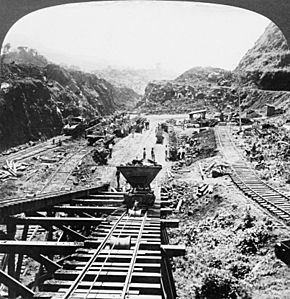
Roosevelt wanted to build a canal through Central America. This canal would connect the Atlantic Ocean and the Pacific Ocean. Most members of Congress preferred a canal through Nicaragua. Nicaragua was eager to make a deal. But Roosevelt preferred the isthmus of Panama. Panama was loosely controlled by Colombia.
Colombia had been in a civil war since 1898. A previous attempt to build a canal in Panama had failed. A commission appointed by McKinley had suggested a canal through Nicaragua. But it noted that a Panama canal might be cheaper and faster. Roosevelt and his advisors favored the Panama Canal. They believed a war with a European power might break out soon. The U.S. fleet would be split between two oceans until the canal was done.
After a long debate, Congress passed the Spooner Act of 1902. This law gave Roosevelt $170 million to build the Panama Canal. After this, Roosevelt's administration began talking with the Colombian government. They discussed building a canal through Panama.
The U.S. and Colombia signed the Hay–Herrán Treaty in January 1903. This treaty gave the U.S. a lease across Panama. But the Colombian Senate refused to approve the treaty. They wanted more money from the U.S. and more control over the canal zone.
Panamanian rebels wanted to break away from Colombia. They asked the U.S. for military help. Roosevelt saw the leader of Colombia as corrupt. He believed Colombia had acted unfairly by rejecting the treaty. When a rebellion started in Panama, Roosevelt sent the USS Nashville. This ship stopped the Colombian government from sending soldiers to Panama. Colombia could not regain control of the province.
Soon after Panama declared its independence in November 1903, the U.S. recognized Panama as a country. Then, they started talks about building the canal.
Secretary of State Hay and French diplomat Philippe-Jean Bunau-Varilla quickly negotiated a new treaty. Bunau-Varilla represented the Panamanian government. The Hay–Bunau-Varilla Treaty was signed on November 18, 1903. It created the Panama Canal Zone. The U.S. would control this zone. It also ensured the building of the canal. Panama sold the Canal Zone to the U.S. for $10 million and a growing yearly payment.
In February 1904, Roosevelt got the Senate to approve the treaty. The Isthmian Canal Commission was set up to govern the zone. It also oversaw the canal's construction. Roosevelt appointed George Whitefield Davis as the first governor. John Findley Wallace was the first Chief Engineer. When Wallace resigned, Roosevelt appointed John Frank Stevens. Stevens built a railroad in the canal zone. He also started building a lock canal. Stevens was replaced in 1907 by George Washington Goethals. Goethals saw the construction through to the end. Roosevelt visited Panama in November 1906. He was the first sitting president to travel outside the United States.
East Asia Relations
Russo-Japanese War
Russia had taken over the Chinese region of Manchuria after the Boxer Rebellion in 1900. The U.S., Japan, and Britain all wanted Russia to leave. Russia agreed to pull out its forces in 1902. But it broke this promise and tried to gain more power in Manchuria.
Roosevelt didn't want to use the military in that distant region. But Japan prepared for war against Russia. The Russo-Japanese War began in February 1904. Roosevelt sympathized with Japan. But he wanted to be a mediator in the conflict. He hoped to keep the Open Door policy in China. He also wanted to prevent either country from becoming too powerful in East Asia.
Japan gained a big advantage after capturing the Russian naval base at Port Arthur in January 1905. In mid-1905, Roosevelt convinced both sides to meet for a peace conference. It started on August 5 in Portsmouth, New Hampshire. His efforts led to the signing of the Treaty of Portsmouth on September 5. This ended the war. For his work, Roosevelt won the 1906 Nobel Peace Prize. The treaty made Russia remove its troops from Manchuria. It also gave Japan control of Korea and the southern half of Sakhalin Island.
Problems with Japan
The U.S. took over Hawaii in 1898 partly because it feared Japan might control it. Similarly, Japan was an alternative to the U.S. taking over the Philippines in 1900. These events were part of the U.S. becoming a naval world power. But it needed to avoid a military conflict with Japan in the Pacific. Maintaining friendly relations with Japan was a high priority for Theodore Roosevelt.
In the late 1800s, many Japanese families moved to Hawaii to work on sugar plantations. About 124,000 Japanese workers came. When Hawaii became part of the U.S. in 1898, Japanese people were the largest group there.
President Roosevelt made sure there was a plan to defend the islands from possible Japanese attack. This was especially true in 1907 when tensions were high. He met with military and naval leaders. They decided on operations in the Philippines. These included sending coal, food, guns, and ammunition.
A 1907 magazine cover showed President Theodore Roosevelt defending Japan. He was shown confronting U.S. newspapers. The caption said that talk of war between the U.S. and Japan came from these newspapers. They wanted to sell more copies. Much of the conflict was caused by racism against Japanese Americans in California.
Roosevelt saw Japan as the rising power in Asia. This was in terms of military strength and modern economy. He viewed Korea as a less developed nation. He didn't object to Japan taking control of Korea. The U.S. showed it wouldn't intervene to stop Japan's takeover of Korea.
In mid-1905, Taft and Japanese Prime Minister Katsura Tarō created the Taft–Katsura agreement. This agreement didn't decide anything new. But each side made its position clear. Japan said it had no interest in the Philippines. The U.S. said it considered Korea to be under Japan's influence.
Regarding China, the two nations worked with European powers to stop the Boxer Rebellion in 1900. But the U.S. was increasingly worried about Japan not following the Open Door Policy. This policy ensured all nations could trade with China equally.
Strong anti-Japanese feelings (especially on the West Coast) hurt relations. President Theodore Roosevelt didn't want to anger Japan by banning Japanese immigration. Instead, there was an informal "Gentlemen's Agreement of 1907". This was between U.S. and Japanese foreign ministers. Japan agreed to stop Japanese laborers from moving to the U.S. or Hawaii. In return, there would be no segregation in California. These agreements lasted until 1924. Then, Congress banned all immigration from Japan, which angered Japan.
Historian Charles Neu says Roosevelt's policies were a success. He concludes that Roosevelt's diplomacy was "shrewd, skillful, and responsible."
Pogroms in Russia
Repeated attacks on Jews in Russia, called a pogrom, angered Americans. German Jews in the U.S. were well organized. They convinced Washington to support Jews in Russia. Leaders like Oscar Straus and Jacob Schiff organized protests. They met with Roosevelt and Secretary of State John Hay.
In April 1903, Roosevelt received many letters and petitions. Thousands of Christians called on the Tsar to stop the persecution of Jews. Public rallies were held in many cities. Roosevelt openly condemned the Kishinev pogrom. But Roosevelt was mediating the war between Russia and Japan. So, he couldn't publicly take sides. Secretary Hay took the lead in Washington.
Finally, Roosevelt sent a petition to the Tsar. The Tsar rejected it. Roosevelt won Jewish support in his 1904 re-election. The pogroms continued. Hundreds of thousands of Jews fled Russia. Most went to London or New York. American public opinion turned against Russia. Congress officially condemned Russia's policies in 1906. Roosevelt kept a low profile. However, in late 1906, Roosevelt appointed the first Jewish person to his cabinet. This was Oscar Straus, who became Secretary of Commerce and Labor.
Elections During Roosevelt's Presidency
The 1904 Election
Roosevelt had strong support within the Republican Party. But his re-nomination in 1904 was not certain in 1901. Many thought Senator Mark Hanna would win the party's nomination. Hanna had strong support from conservative businessmen. They opposed many of Roosevelt's policies. However, Hanna and another leader, Matthew Quay, both died in 1904. Other possible rivals failed to gain support.
At the 1904 Republican National Convention, Roosevelt secured his own nomination. But his preferred vice-presidential running mate was not chosen. Instead, Senator Charles W. Fairbanks, a favorite of conservatives, became the vice-presidential nominee.
The Democratic Party's nominee in 1904 was Alton B. Parker. He was a chief judge from New York. Democrats hoped Parker would unite the party. But Parker couldn't unite the party. Many Democrats even supported Roosevelt. Democrats claimed the Republican campaign got large donations from corporations unfairly. But these claims didn't affect the election much.
Roosevelt won 56% of the popular vote. Parker received 38%. Roosevelt also won the electoral vote 336 to 140. Roosevelt's victory made him the first president to be elected to a full term after taking office due to a predecessor's death. His popular vote margin of 18.8% was the largest until the 1920 election. On election night, Roosevelt promised not to run for a third term.
The 1908 Election and Transition
Roosevelt had mixed feelings about a third term. He enjoyed being president and was still young. But he felt that limiting terms prevented a dictatorship. Roosevelt decided to stick to his 1904 promise not to run again. He supported a successor to avoid a rush of pro-Roosevelt delegates at the 1908 Republican National Convention.
Roosevelt personally favored Secretary of State Elihu Root. But Root's poor health made him unsuitable. New York Governor Charles Evans Hughes was a strong candidate. He shared Roosevelt's progressive ideas. But Roosevelt didn't like him much and thought he was too independent.
Instead, Roosevelt chose his Secretary of War, William Howard Taft. Taft had served well under previous presidents. Roosevelt and Taft had been friends since 1890. Taft had always supported President Roosevelt's policies. Many conservatives wanted to take back control of the party from Roosevelt. Senator Joseph B. Foraker briefly tried to become the main conservative candidate. However, Taft defeated Foraker's attempt to control the Ohio Republican Party. Taft became the strong favorite at the convention.
At the 1908 Republican convention, many people chanted for "four years more" of Roosevelt. But Taft won the nomination. Roosevelt's close friend, Henry Cabot Lodge, made it clear that Roosevelt wasn't interested in a third term. In his acceptance speech, Taft promised to continue Roosevelt's policies. But as the campaign went on, he relied less on Roosevelt. He didn't ask the president to campaign for him publicly.
The Democrats nominated William Jennings Bryan. He had been the party's presidential candidate in 1896 and 1900. Bryan was a popular speaker. He thought Taft was a weak candidate. He hoped the public was tired of Republican leadership since the 1896 election.
The two parties' platforms were very similar. Both called for actions against monopolies, railroad and labor rules, and changes to tariffs. As election day neared, it was clear Taft would win. He won 321 of 483 electoral votes and 51.6% of the popular vote. Republicans also kept control of both houses of Congress.
Roosevelt saw Taft's victory as proof that his policies and presidency were successful. As he left office, Roosevelt was seen as one of the most powerful presidents since Abraham Lincoln. Taft's decision to keep few of Roosevelt's cabinet members upset Roosevelt. But Roosevelt continued to support Taft during the transition.
Roosevelt's Place in History
Roosevelt was popular when he left office. He remained a major world figure until he died in 1919. People at the time saw his presidency as very important. Former Senator William E. Chandler wrote in 1909 that Roosevelt "changed the course of American politics."
After his death, other figures became more famous. But historians and the public became interested in Roosevelt again after World War II. Historian John Morton Blum said Roosevelt was the first truly modern president. Many historians believe Roosevelt's presidency set an example for future presidents.
Historian Lewis L. Gould summarizes what historians generally agree on. He says Roosevelt was "a strong, effective executive whose policies foreshadowed the welfare state." Gould also writes that Roosevelt is rated as "near great" by historians. A 2018 poll ranked Roosevelt as the fourth greatest president in history. He was ranked after George Washington, Abraham Lincoln, and Franklin D. Roosevelt.
Roosevelt is seen as a hero by modern liberals. This is because of his ideas from 1907–1912. These ideas were similar to the modern welfare state of the New Deal Era. He also put the environment on the national agenda. Conservatives admire his "big stick" diplomacy and his commitment to military values.
Historian Dalton says, "Today he is heralded as the architect of the modern presidency. He was a world leader who boldly reshaped the office to meet the needs of the new century. He also redefined America's place in the world." However, some critics say he was too interventionist. They say he was too imperialist toward nations he considered "uncivilized." Conservatives disagree with his ideas about the welfare state. They also disagree with his focus on government action over private action.
|


